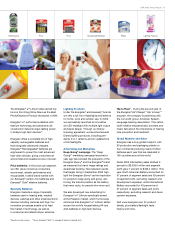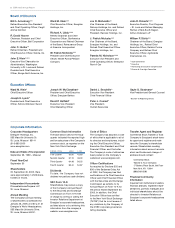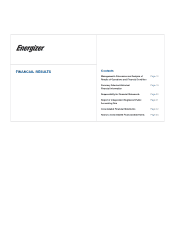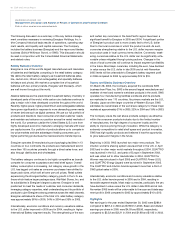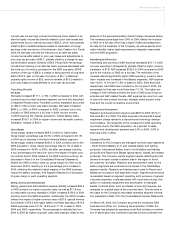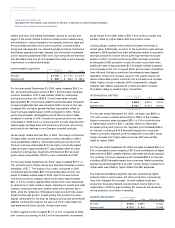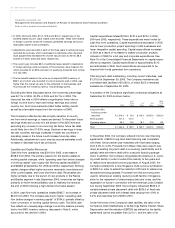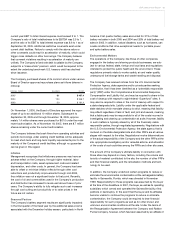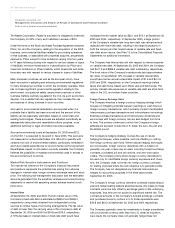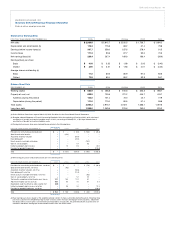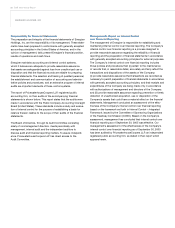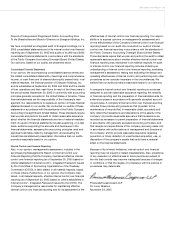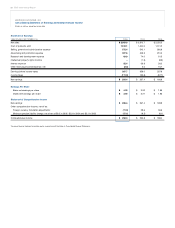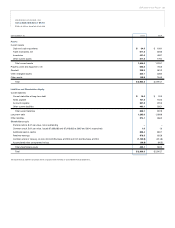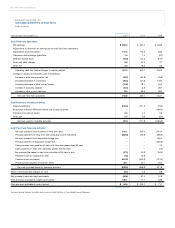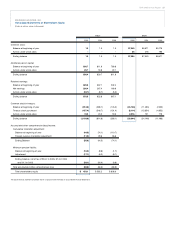Energizer 2005 Annual Report Download - page 17
Download and view the complete annual report
Please find page 17 of the 2005 Energizer annual report below. You can navigate through the pages in the report by either clicking on the pages listed below, or by using the keyword search tool below to find specific information within the annual report.
ENR 2005 Annual Report 15
current year EBIT to total interest expense must exceed 3 to 1. The
Company’s ratio of total indebtedness to its EBITDA was 2.5 to 1,
and the ratio of its EBIT to total interest expense was 8.6 to 1 as of
September 30, 2005. Additional restrictive covenants exist under
current debt facilities. Failure to comply with the above ratios or
other covenants could result in acceleration of maturity, which could
trigger cross defaults on other borrowings. The Company believes
that covenant violations resulting in acceleration of maturity are
unlikely. The Company’s fixed rate debt is callable by the Company,
subject to a “make whole” premium, which would be required to the
extent the underlying benchmark U.S. treasury yield has declined
since issuance.
The Company purchased shares of its common stock under various
Board of Director-approved repurchase plans as follows (shares in
millions):
FISCAL YEAR SHARES COST
2005 8.1 $ 457.4
2004 13.4 $ 546.7
2003 5.0 $ 131.4
On November 1, 2005, the Board of Directors approved the repur-
chase of up to an additional 10 million shares. Subsequent to
September 30, 2005 and through November 18, 2005, approxi-
mately 1.4 million shares were purchased for $67.0 under the most
recent authorization. As of November 18, 2005, there are 8.7 million
shares remaining under the current authorization.
The Company believes that cash flows from operating activities and
periodic borrowings under existing credit facilities will be adequate
to meet short-term and long-term liquidity requirements prior to the
maturity of the Company’scredit facilities, although no guarantee
can be given in this regard.
Inflation
Management recognizes that inflationary pressures may have an
adverse effect on the Company, through higher material, labor
and transportation costs, asset replacement costs and related
depreciation, and other costs. In general, the Company has been
able to offset or minimize inflation effects through other cost
reductions and productivity improvements through mid-2005,
thus inflation was not a significant factor to that point. Recently,
the cost of oil and commodities used in the Company’sproduction
and distribution has increased to levels well above those of prior
years. The Company’s ability to fully mitigate such cost increases
through cost cutting and productivity or to raise prices in the
future are not certain.
Seasonal Factors
The Company’s battery segment results are significantly impacted
in the first quarter of the fiscal year by the additional sales volume
associated with the December holiday season, particularly in North
America. First quarter battery sales accounted for 31% of total
battery net sales in both 2005 and 2004 and 32% of total battery net
sales in 2003. In addition, natural disasters, such as hurricanes, can
create conditions that drive exceptional needs for portable power
and spike battery sales.
Environmental Matters
The operations of the Company, like those of other companies
engaged in the battery and shaving products businesses, are sub-
ject to various federal, state, foreign and local laws and regulations
intended to protect the public health and the environment. These
regulations primarily relate to worker safety, air and water quality,
underground fuel storage tanks and waste handling and disposal.
The Company has received notices from the U.S. Environmental
Protection Agency,state agencies and/or private parties seeking
contribution, that it has been identified as a “potentially responsible
party” (PRP) under the Comprehensive Environmental Response,
Compensation and Liability Act, and may be required to share in the
cost of cleanup with respect to eight federal “Superfund” sites. It
may also be required to share in the cost of cleanup with respect to
astate-designated site. Liability under the applicable federal and
state statutes which mandate cleanup is strict, meaning that liability
may attach regardless of lack of fault, and joint and several, meaning
that a liable party may be responsible for all of the costs incurred in
investigating and cleaning up contamination at a site. However, liability
in such matters is typically shared by all of the financially viable
responsible parties, through negotiated agreements. Negotiations with
the U.S. Environmental Protection Agency,the state agency that is
involved on the state-designated site and other PRPs are at various
stages with respect to the sites. Negotiations involve determinations
of the actual responsibility of the Company and the other PRPs at the
site, appropriate investigatory and/or remedial actions, and allocation
of the costs of such activities among the PRPs and other site users.
The amount of the Company’s ultimate liability in connection with
those sites may depend on many factors, including the volume and
toxicity of material contributed to the site, the number of other PRPs
and their financial viability, and the remediation methods and tech-
nology to be used.
In addition, the Company undertook certain programs to reduce or
eliminate the environmental contamination at the rechargeable battery
facility in Gainesville, Florida, which was divested in November
1999. Responsibility for those programs was assumed by the buyer
at the time of the divestiture. In 2001, the buyer, as well as its operating
subsidiary which owned and operated the Gainesville facility, filed
petitions in bankruptcy. In the event that the buyer and its affiliates
become unable to continue the programs to reduce or eliminate
contamination, the Company could be required to bear financial
responsibility for such programs as well as for other known and
unknown environmental conditions at the site. Under the terms of
the Reorganization Agreement between the Company and Ralston
Purina Company, however, which has been assumed by an affiliate of


